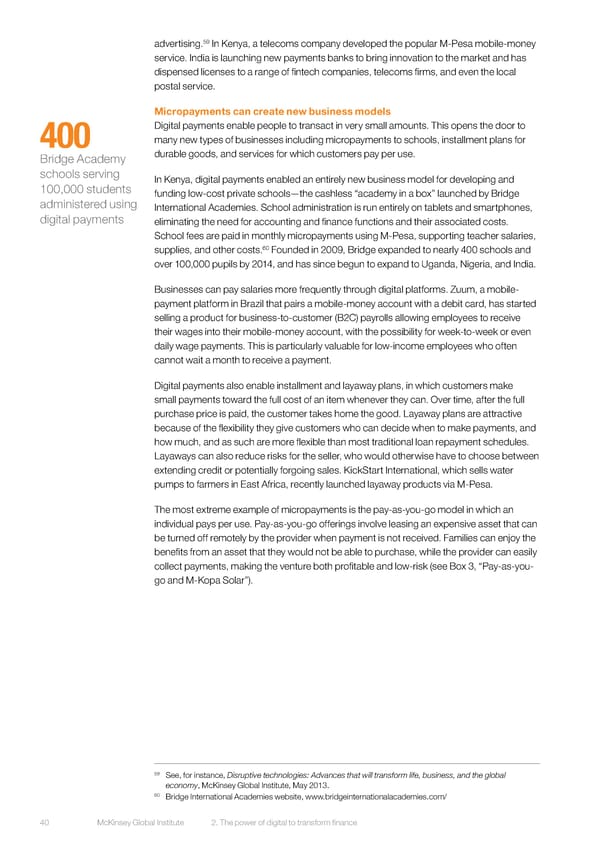59 advertising. In Kenya, a telecoms company developed the popular M-Pesa mobile-money service. India is launching new payments banks to bring innovation to the market and has dispensed licenses to a range of fintech companies, telecoms firms, and even the local postal service. Micropayments can create new business models Digital payments enable people to transact in very small amounts. This opens the door to 400 many new types of businesses including micropayments to schools, installment plans for Bridge Academy durable goods, and services for which customers pay per use. schools serving In Kenya, digital payments enabled an entirely new business model for developing and 100,000 students funding low-cost private schools—the cashless “academy in a box” launched by Bridge administered using International Academies. School administration is run entirely on tablets and smartphones, digital payments eliminating the need for accounting and finance functions and their associated costs. School fees are paid in monthly micropayments using M-Pesa, supporting teacher salaries, 60 supplies, and other costs. Founded in 2009, Bridge expanded to nearly 400 schools and over 100,000 pupils by 2014, and has since begun to expand to Uganda, Nigeria, and India. Businesses can pay salaries more frequently through digital platforms. Zuum, a mobile- payment platform in Brazil that pairs a mobile-money account with a debit card, has started selling a product for business-to-customer (B2C) payrolls allowing employees to receive their wages into their mobile-money account, with the possibility for week-to-week or even daily wage payments. This is particularly valuable for low-income employees who often cannot wait a month to receive a payment. Digital payments also enable installment and layaway plans, in which customers make small payments toward the full cost of an item whenever they can. Over time, after the full purchase price is paid, the customer takes home the good. Layaway plans are attractive because of the flexibility they give customers who can decide when to make payments, and how much, and as such are more flexible than most traditional loan repayment schedules. Layaways can also reduce risks for the seller, who would otherwise have to choose between extending credit or potentially forgoing sales. KickStart International, which sells water pumps to farmers in East Africa, recently launched layaway products via M-Pesa. The most extreme example of micropayments is the pay-as-you-go model in which an individual pays per use. Pay-as-you-go offerings involve leasing an expensive asset that can be turned off remotely by the provider when payment is not received. Families can enjoy the benefits from an asset that they would not be able to purchase, while the provider can easily collect payments, making the venture both profitable and low-risk (see Box 3, “Pay-as-you- go and M-Kopa Solar”). 59 See, for instance, Disruptive technologies: Advances that will transform life, business, and the global economy, McKinsey Global Institute, May 2013. 60 Bridge International Academies website, www.bridgeinternationalacademies.com/ 40 McKinsey Global Institute 2. The power of digital to transform finance
 DIGITAL FINANCE FOR ALL Page 52 Page 54
DIGITAL FINANCE FOR ALL Page 52 Page 54